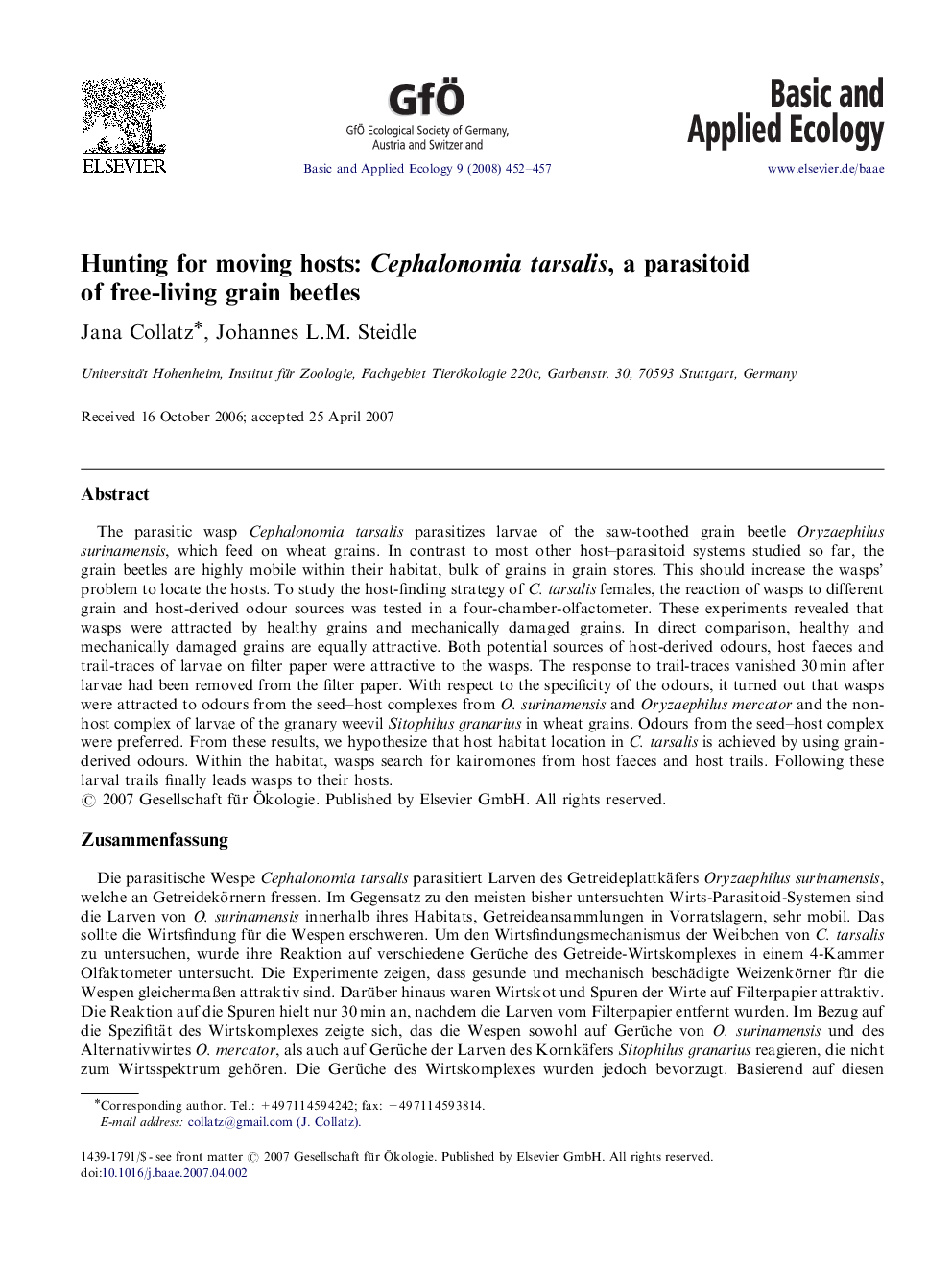| Article ID | Journal | Published Year | Pages | File Type |
|---|---|---|---|---|
| 4384679 | Basic and Applied Ecology | 2008 | 6 Pages |
The parasitic wasp Cephalonomia tarsalis parasitizes larvae of the saw-toothed grain beetle Oryzaephilus surinamensis, which feed on wheat grains. In contrast to most other host–parasitoid systems studied so far, the grain beetles are highly mobile within their habitat, bulk of grains in grain stores. This should increase the wasps’ problem to locate the hosts. To study the host-finding strategy of C. tarsalis females, the reaction of wasps to different grain and host-derived odour sources was tested in a four-chamber-olfactometer. These experiments revealed that wasps were attracted by healthy grains and mechanically damaged grains. In direct comparison, healthy and mechanically damaged grains are equally attractive. Both potential sources of host-derived odours, host faeces and trail-traces of larvae on filter paper were attractive to the wasps. The response to trail-traces vanished 30 min after larvae had been removed from the filter paper. With respect to the specificity of the odours, it turned out that wasps were attracted to odours from the seed–host complexes from O. surinamensis and Oryzaephilus mercator and the non-host complex of larvae of the granary weevil Sitophilus granarius in wheat grains. Odours from the seed–host complex were preferred. From these results, we hypothesize that host habitat location in C. tarsalis is achieved by using grain-derived odours. Within the habitat, wasps search for kairomones from host faeces and host trails. Following these larval trails finally leads wasps to their hosts.
ZusammenfassungDie parasitische Wespe Cephalonomia tarsalis parasitiert Larven des Getreideplattkäfers Oryzaephilus surinamensis, welche an Getreidekörnern fressen. Im Gegensatz zu den meisten bisher untersuchten Wirts-Parasitoid-Systemen sind die Larven von O. surinamensis innerhalb ihres Habitats, Getreideansammlungen in Vorratslagern, sehr mobil. Das sollte die Wirtsfindung für die Wespen erschweren. Um den Wirtsfindungsmechanismus der Weibchen von C. tarsalis zu untersuchen, wurde ihre Reaktion auf verschiedene Gerüche des Getreide-Wirtskomplexes in einem 4-Kammer Olfaktometer untersucht. Die Experimente zeigen, dass gesunde und mechanisch beschädigte Weizenkörner für die Wespen gleichermaßen attraktiv sind. Darüber hinaus waren Wirtskot und Spuren der Wirte auf Filterpapier attraktiv. Die Reaktion auf die Spuren hielt nur 30 min an, nachdem die Larven vom Filterpapier entfernt wurden. Im Bezug auf die Spezifität des Wirtskomplexes zeigte sich, das die Wespen sowohl auf Gerüche von O. surinamensis und des Alternativwirtes O. mercator, als auch auf Gerüche der Larven des Kornkäfers Sitophilus granarius reagieren, die nicht zum Wirtsspektrum gehören. Die Gerüche des Wirtskomplexes wurden jedoch bevorzugt. Basierend auf diesen Ergebnissen lässt sich das folgende hypothetische Wirtsfindungsszenario entwickeln. Zunächst erfolgt die Wirtshabitatfindung von C. tarsalis über die Verwendung von Korngerüchen. Innerhalb des Habitats suchen die Wespen nach Wirtskot und Gerüchen von Larvenspuren. Letztere zeigen Areale an, in denen Wirte noch kurz vorher aktiv waren. Durch Verfolgen dieser Larvenspuren finden die Wespen schließlich ihre Wirte.
